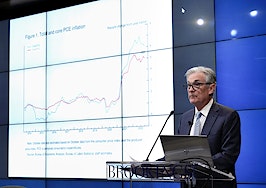At Inman Connect Las Vegas, July 30-Aug. 1, 2024, the noise and misinformation will be banished, all your big questions will be answered, and new business opportunities will be revealed. Join us.
Federal Reserve policymakers aren’t as eager to cut interest rates as they were in March, but investors who fund most mortgages are still betting that the central bank will change its tune if inflation continues to ease.
As expected, Fed policymakers left their target for the short-term federal funds rate unchanged Wednesday at an inflation-fighting level of 5.25 percent to 5.5 percent, where it’s been since July 2023.
More significantly, in a highly anticipated quarterly update of the Fed’s “dot plot,” members of the rate-setting Federal Open Market Committee said they only envision making one 25 basis-point rate cut this year.
The last time the central bank updated the Summary of Economic Projections, in March, the dot plot showed that policymakers were expecting to make three rate cuts totaling 75 basis points in 2024. A basis point is one-hundredth of a percentage point.
With a surprisingly encouraging inflation report coming out just hours before the conclusion of Wednesday’s two-day Fed meeting, some forecasters had been expecting the dot plot would telegraph at least two rate cuts.
The dot plot — and remarks delivered by Federal Reserve Chairman Jerome Powell at a press conference following the meeting — threw cold water on those hopes — for now.
“Inflation has eased substantially from a peak of 7 percent to 2.7 percent, but is still too high,” Powell said. “We are strongly committed to returning inflation to our 2 percent goal in support of a strong economy that benefits everyone.”
The latest Consumer Price Index (CPI) report released Wednesday morning by the Bureau of Labor Statistics showed prices rose 3.27 percent in May from a year ago, down from 3.36 percent in April.
The Federal Reserve’s preferred inflation gauge, the Personal Consumption Expenditures (PCE) price index, is even closer to the Fed’s 2 percent inflation target than CPI, registering 2.65 percent in April.
The May update of the PCE index, which is based on CPI and Producer Price Index (PPI) numbers set to be released Thursday, is due June 28.
Treasury yields yo-yo

Source: Yahoo Finance.
Yields on 10-year Treasury notes had plummeted to 4.25 percent Wednesday morning after the release of the CPI report for May, as bond market investors who fund most mortgages raised their expectations for several Fed rate cuts this year.
But after Fed policymakers wrapped up their meeting at 11 a.m. and Powell began briefing reporters, the 10-year yield rebounded to 4.31 percent as markets digested the Fed’s seemingly hawkish stance.
The tight job market, highlighted by a surprisingly strong May jobs report released on Friday, is “likely leading many members to continue to be cautious about cutting rates before inflation is consistently lower,” Mortgage Bankers Association Chief Economist Mike Fratantoni said, in a statement.
“Although May’s [CPI] inflation data came in better than expected, perhaps surprisingly, the [Federal Open Market Committee is now projecting only one rate cut in 2024,” Fratantoni said. “However, it is notable that the dot plot indicates it is a close call between one and two cuts.”
After Wednesday’s CPI release and Fed meeting, futures markets tracked by the CME FedWatch tool still put the odds of at least two Fed rate cuts this year at 61 percent, up from 52 percent on Tuesday. While the Fed has tight control over short-term interest rates, it’s investor demand for long-term Treasurys and mortgage-backed securities — fueled in part by expectations of future Fed moves — that largely determines long-term interest rates.
The Fed’s latest ‘dot plot’

Source: Federal Reserve Summary of Economic Projections, June 2024.
The dot plot shows eight members of the Federal Open Market Committee still think the Fed will have to make two cuts this year in order to keep the economy humming, which would bring the short-term federal funds rate down to a target of 4.75 percent to 5 percent.
“If the economy evolves as expected, the median participant judges the appropriate level of the federal funds rate will be 5.1 percent at the end of this year, 4.1 percent at the end of 2025 and 3.1 percent at the end of 2026,” Powell said of the dot plot.
But the dot plot does not represent an economic plan or decision, Powell cautioned.
“If the economy remains solid and inflation persists we’re prepared to maintain the [current] target range for the federal funds rate as long as appropriate,” Powell said. “If the labor market were to weaken unexpectedly or if inflation were to fall more quickly than anticipated, we’re prepared to respond” with more drastic rate cuts.
Asked if policymakers are concerned that leaving rates where they are now for too long could harm the housing industry or create financial instability, Powell said that banks have been focusing on building capital and having risk management plans in place, “So the banking system seems to be in good shape.”
But the housing situation “is a complicated one,” he acknowledged, and elevated mortgage rates are having a significant effect on buyers and sellers.
“Ultimately the best thing we can do for the housing market is to bring inflation down, so we can bring rates down so that the housing market continues to normalize,” Powell said.
“There will still be a national housing shortage as there was before the pandemic,” he said, but lower rates should help address market distortions created by existing homeowners feeling locked in to their current low rates.
CoreLogic Chief Economist Selma Hepp said in a statement that with today’s announcement, “the Fed confirms its higher-for-longer position on interest rates. But the stance is looking more untenable as more American households continue to pull back on spending.”
“As more economic indicators begin to confirm this and unemployment begins to rise, the Fed will then look to cut rates,” Hepp predicted. “What’s not clear yet is when exactly the disinflation signs will be consistent enough for the first rate cut — we hope it’s still this year.”
Pantheon Macroeconomics Chief Economist Ian Shepherdson said he expects that the “unnecessarily aggressive dot plot” will have “a short shelf-life,” and that the Fed will ultimately need to bring rates down by 1.25 percentage points this year to keep the economy from cooling too quickly.
“We think the Fed will soon have to backtrack from the new dot plot because the labor market likely will soften materially over the summer, while core PCE likely will be better than policymakers expect,” Shepherdson said in a note to clients. “We still think the first easing will come in September, and our labor market and inflation projections then suggest the Fed will be scrambling to catch up after starting to ease too late, and we look for 50 [basis point] easings in both November and December.”
The dot plot also shows general agreement that the Fed will need to bring the federal funds rate down to a target of 4 percent to 4.25 percent by the end of 2025, or 1.25 percentage points lower than today’s target.
“Once it starts, this cutting cycle is likely to be shorter than past cycles,” Fratantoni said. “Today’s announcement does not change our forecast for mortgage rates. We still look for mortgage rates to drop to about 6.5 percent by the end of 2024.”
MBA, Fannie Mae mortgage rate forecasts

In a May 16 forecast, MBA economists said they expected rates to drop to 6.5 percent by the end of this year, and below 6 percent by the end of 2025.
Fannie Mae economists said in a May 13 forecast they don’t see rates on 30-year fixed-rate loans dropping below 7 percent until next year, and then falling only gradually to an average of 6.6 percent in Q4 2025.
Since hitting a 2024 high of 7.27 percent on April 25, rates on 30-year fixed-rate mortgages have mostly been on the decline in recent weeks, according to rate lock data tracked by Optimal Blue.
During the week ending June 7, applications for purchase loans were up a seasonally adjusted 9 percent from the week before, and applications to refinance were up 28 percent, the MBA reported Wednesday.
“Even with the Fed pumping the brakes on potential rate cuts, larger mortgage companies could be in line for better earnings in the coming months with homebuying picking up and less competition for originations compared to last year,” Fitch Ratings Senior Director Eric Orenstein said in a statement.
Get Inman’s Mortgage Brief Newsletter delivered right to your inbox. A weekly roundup of all the biggest news in the world of mortgages and closings delivered every Wednesday. Click here to subscribe.













